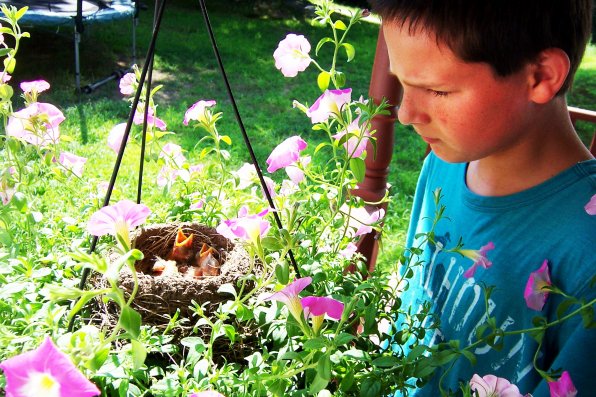With its familiar brick-red breast, the American robin is one of our most recognizable songbirds, and is no doubt the first bird a child learns to identify. A native of North America, it is called the American robin because it was named after the similar European robin.
Now that the days are getting shorter, our robins are becoming restless and more social. They are feasting on fruits and berries to build up their fat reserves in preparation for their migratory flight south. Large flocks of robins will soon be on the move.
Since robins are one of the first songbirds to return at the end of winter, they are regarded as a symbol and harbinger of spring. They are state birds for Connecticut, Michigan and Wisconsin.
Robins can have two or three broods per breeding season, each brood having a new nest which is built with coarse grass and twigs plastered together with mud and cushioned with soft grass. Their three-to-five bright blue eggs hatch in 14 days and the fledglings leave the nest two weeks later.
In addition to fruits and berries, beetle grubs and earthworms make up a robin's diet. There has been speculation and research to determine how robins locate earthworms. You have seen a robin hopping across the lawn and stopping abruptly to cock its head, first one way and then another, in its search for earthworms. It is believed that the robin uses all its senses, visual, auditory, olfactory and vibratory, to find its prey. Especially vision.
This summer, we watched a pair of robins build their nest in a hanging flower pot on our side porch here in Concord. Eventually, three eggs appeared in the nest. Our entire family was excited when we saw that the eggs had hatched. We were amazed that the baby birds had such large wide-open beaks in relation to their small naked bodies, particularly when they were eager to be fed.
Parent robins have been known to make 100 trips each day to feed their hungry babies in the nest. During their first days out of the nest, the fledglings will still be begging their parents for food until they learn to forage for themselves.
Rebecca Suomala of the New Hampshire Audubon Society of Concord is chairwoman of the annual New Hampshire Backyard Winter Bird Survey. She mentioned that statewide there were 1882 and 1081 American robins counted in the winter surveys of 2010 and 2011 respectively. You can find information about the next survey at nhaudubon.org.
The robin's rapid outburst of song, “cheer-up, cheer-up, cheer-up,” is heard at daybreak and also is a vespers melody at evening twilight. However, ornithologists are quick to point out that the morning and evening songs of the robin are slightly different.
Henry David Thoreau philosophized eloquently in describing the robin's song: “I hear a robin singing cheerily in the midst of rain. It sings with power, like a bird of great faith that sees the bright future through the dark present, to reassure the race of man. The sounds make a dying man live. It is a pure immortal melody.”









